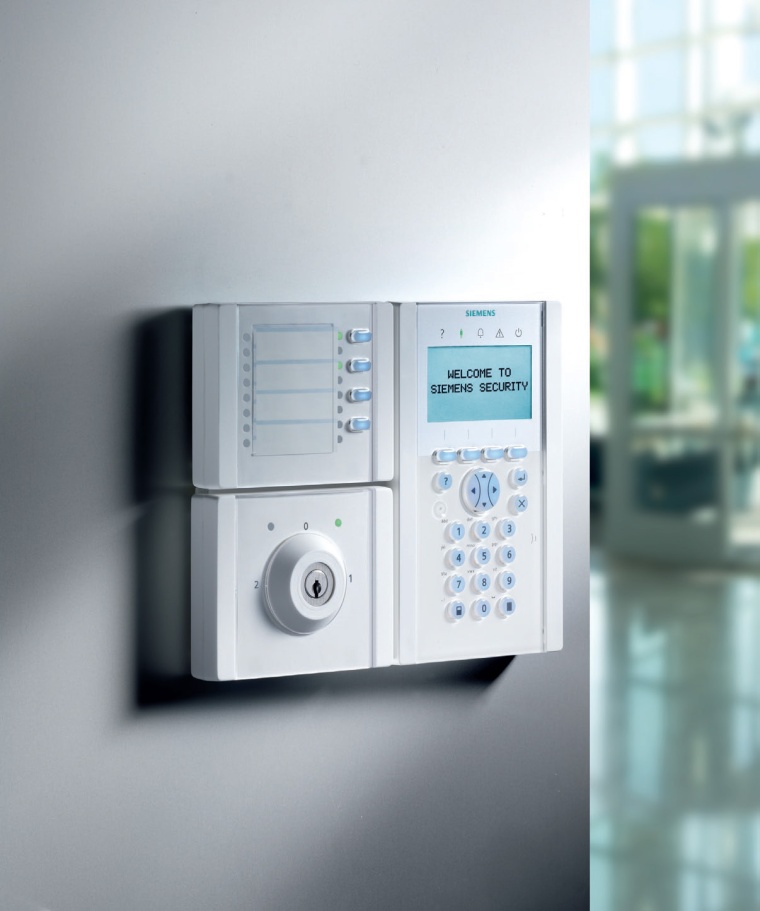Siemens Building Technologies: intrusion detection - an integral part of the security future
Siemens Building Technologies: intrusion detection - an integral part of the security future. Intrusion is sometimes seen as the old technology which has not made the advances of i...


Siemens Building Technologies: intrusion detection - an integral part of the security future. Intrusion is sometimes seen as the old technology which has not made the advances of its younger siblings video surveillance and access control. Whilst this is partly understandable, given that intrusion detection was effectively first on the electronic security scene, the reality is very different. When you consider intrusion in its wider context and look beyond the simple alarm, significant developments have been and continue to be made to address new security requirements.
Intruder Alarms – Not So Basic
After All Intrusion systems have evolved beyond the basic alarm triggering function into multi-functional systems, with stringent performance requirements for detection reliability, alarm transmission and alarm management - some of the detection technologies deployed by Siemens Building Technologies (Siemens BT) rely on, for example, very sophisticated algorithms to ensure high detection rates and false alarm immunity.
Intrusion has also embraced new technologies, such as IP and wireless, although this has not been the subject of open debates as with e.g. video surveillance. This evolution is further accentuated by the requirement for integration into complete security systems, the outsourcing of alarm monitoring and the integration with building management systems for energy and cost efficiency purposes. This need for intrusion systems to deliver highly sophisticated functionality has also driven the adoption of new technologies in the field of electronics.
They play an important role in the performance of intrusion systems, particularly in alarm transmission and management, as they define how much data can be processed reliably and at what speed. Faster, more powerful micro processors mean that intrusion systems can adapt to the ever increasing complexity of the security requirements and the demand for multifunctionality. This also means that the equipment is not so “power hungry”, reducing the risk of “system overload” and leaving room for future system expansions or upgrades.
So, intrusion is neither old nor basic technology and is indeed still the first choice to solve many practical security problems. New standards and certifications are continuously being developed, which also shows that intrusion technologies are constantly evolving. However, we are conscious of the fact that the market sometimes views intrusion as “old news”. This is the key reason why we are introducing a new brand for our professional range of intrusion products and systems, Intrunet.
It’s Time to Think Again
We want the market to take a fresh look at our portfolio and at intrusion technologies in general and recognise that today’s intrusion systems offer everything modern security demands and more. Scalability, modularity, superior detection capability, highest false alarm immunity, functional customisation and integration as well as support for alarm management and response services, to name but a few.
Over its 30 year security history, Siemens BT has supplied intrusion products and systems under a number of different brands and sub brands, often as a result of acquisitions. The need for integration with access control and video surveillance systems is becoming more urgent and our customers are looking to us to facilitate this process. The new Intrunet brand draws together all the intrusion technologies that we offer with our motion detectors, control panels and peripherals - and as a result all of our customers’ intrusion requirements.
One brand is easier and cheaper to stock, promote and sell and ultimately to integrate into multi-functional systems. With the new brand, our partners now benefit from a cohesive platform on which to build lasting business and value added services for their end-customers. The Intrunet brand will also enable us to more easily integrate acquired product portfolios, as well as developments from our own extensive R&D.
We are currently known for our patented Black Mirror motion detectors and ingenertroduced the world’s first Grade 4 motion detector last year. Siemens BT now works on enhancing and widening its detector portfolio with a detector range based on a different technology, specifically addressing cost sensitive market segments and distribution channels.
Acquisitions have and will continue to play a fundamental role in our strategy, allowing Siemens to bring new products and technologies to the market quicker. Siemens BT recently acquired a 77% stake in iMetrex Technologies (including the Europlex brand), which adds considerably to our intrusion capability. The European market is our “home” market, but whilst we see a strong demand from the residential and small commercial markets there, we will strive to serve the fastgrowing Asian markets more and more, particularly as we now have a strong leverage with our sister company iMetrex.
iMetrex also supply electronic security and management systems that integrate with fire safety and building automation systems - again an example of integration being at the heart of what we need to do and proof that advanced technologies are being developed for and applied to intrusion systems.
Return on Investment and Value Added Services
To address the demand for system expansion, migration to new technologies and customisation at an affordable price, intrusion systems must be flexible enough to grow and evolve without jeopardising the customer’s initial investment. Security systems are now expected to deliver return on investment. They are increasingly required to support fast changing business environments and processes and to integrate into existing IT and IP networks.
This is a critical success factor not just for our intrusion business, but also for our other security disciplines, access control and video surveillance. The growing involvement of service providers – from IT and Telecommunications companies to Alarm Receiving Centres (ARC) – is also accentuating this trend.
Modern intrusion systems are required to support the full security service packages on offer with secure and reliable alarm transmission, remote alarm management and audio and video verification. False alarms are one of the key challenges in intrusion and audio and video verification are an effective way of validating the level of emergency and measuring what response should be given in case of an alarm. IP is increasingly used for remote video verification as well as alarm transmission, though GSM and GPRS are taking an increasing hold on the latter, enabling notifications to be sent by SMS to anyone, anywhere.
As in security in general, wireless is another important development in intrusion, as it helps bring cabling costs down and provides more flexibility of installation.
The ”Wireless” Challenge
Wireless intrusion systems have been around for 20 years, mainly in residential applications with the purpose of saving installation time. Today we see an increased demand for higher-end applications. However, supplying reliable, secured wireless links together with ultra low-power detection technology remains a challenge. The difficulty here is to combine all available technologies (GSM, WLAN, and Bluetooth) with proprietary security wireless systems without introducing negative interaction.
We see continued growth in wireless intrusion (the wireless detector market is growing 10% in average), but we are still in a transition period during which both wired and wireless devices coexist, sometimes on the same system. “Hybrid” control panels which can support both wired and wireless are therefore in demand - such as those offered by iMetrex, whose range we are about to introduce to our customers.
In the coming years, we will see new innovative wireless technologies for intrusion systems that may change the way we think today.
The Digital Trend Continues
IP brings many benefits in terms of intrusion. It enhances system redundancy capability (“always on” internet reduces the risk of down time, critical for alarm transmission reliability and remote video verification) and also helps reduce the overall cost of system ownership for end-users. Re-using existing IP networks reduces cabling and infrastructure costs and with the cost of bandwidth falling all the time, IP offers very cost effective connectivity.
But moving into the TCP/IP area brings its own challenges - network security is one of these. Whilst private networks are recommended and more easily feasible for commercial organisations to prevent unauthorised access to the intrusion control functions, they are not easily implemented in residential applications. By moving away from the traditional “dedicated intrusion network”, intrusion systems also have to “compete” for bandwidth availability, a critical issue for alarm transmission reliability.
Other practical problems also arise, such as which alarm transmission protocols should be used, the conversion of analogue audio and video data into an IP friendly format, and can a remote connection be secured and maintained with dynamic IP addresses, etc. We strongly believe that these questions call for new standards. This is why we actively support and push the harmonisation efforts with the relevant international standardisation groups.
The standards will help unleash the true benefits IP brings as an “enabler technology”.
To the Future
The global intrusion market is worth in excess of € 5 billion and shows good growth potential overall, particularly in Asia and the Americas. Although intrusion remains a discipline and focus area in its own right for Siemens BT as a manufacturer, we will continue to make significant investments in new technologies to develop our intrusion systems’ “interoperability capability” with access control and video surveillance and also fire safety and building management systems.
So the integration of new technologies will only accelerate, particularly since intrusion systems are increasingly used in the fast growing residential security applications, which already represent 40% of all intrusion installations. In this very cost sensitive segment, reliability is also paramount as most support services are outsourced. This is also where we see a big demand for integration with comfort systems for energy efficiency purposes (for example turning the lights or heating off automatically when the intrusion system is armed).
As more and more devices “speak IP”, a huge potential for interoperability across all disciplines arises. The challenge is to harmonise systems and disciplines which have evolved independently from one another. This is no small task, but with BACnet, already used in our building automation systems, we have a clear contender platform.
When we reach that stage, looking beyond integration within security towards true interoperability in support of “intelligent” buildings, Siemens Building Technologies will be in a unique position as it has in-house security, fire safety and building automation expertise.
Susanne Seitz Eberhard
Contact:
Susanne Seitz Eberhard
Building Technologies Division Siemens Switzerland Ltd,
Zug, Switzerland
Tel.: +41 41 727 4167
Fax: +41 41 723 4621
susanne.seitz@siemens.com
www.siemens.com/buildingtechnologies
most read

GIT SECURITY AWARD 2026 - The winners have been announced!
GIT SECURITY AWARD 2026: The best safety and security solutions of the year - now an overview of all winners

Machine & plant safety: The winners of category A at the GIT SECURITY AWARD 2026
GIT SECURITY AWARD 2026: Machine & plant safety - an overview of the most innovative solutions

Security management, building security & perimeter protection: the winners of category E at the GIT SECURITY AWARD 2026
GIT SECURITY AWARD 2026: Security management, building security & perimeter protection - an overview of the most innovative solutions

Integrated and Futureproof: Traka’s Next Chapter
Interview with Stefni Oliver on Traka’s Vision for the Future









